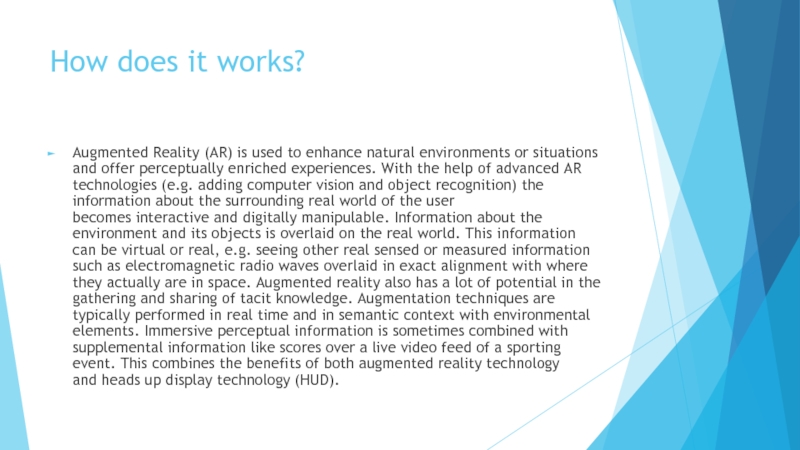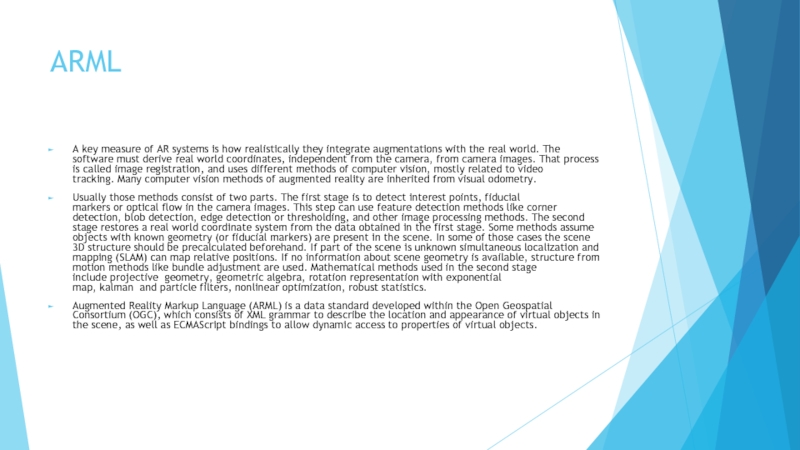Слайд 1Augmented reality
КТмо1-8 Perelekhov I.
КТмо1-8 Manych I.
Слайд 2Contents
Glossary - 3
AR? What does it mean? - 4
How does
it works? - 5
Hardware - 6
Software – 7
ARML - 8
The
Danger of AR - 9
Who do the best AR solutions? - 10
Bibliography - 11
Слайд 3Glossary
AR (AUGMENTED REALITY) - A technology that superimposes a computer-generated
image on a user’s view of the real world, providing
a composite view. AR can be experienced using a smartphone or tablet screen, or wearable devices such as connected glasses (Google, Microsoft, Magic Leap and Apple are all working on AR headset solutions).
VR HEADSET - A VR headset consists of a goggle-like device which includes a display and lenses to let you explore virtual reality environments. There are currently two main types of HMDs: tethered and mobile (or portable).
FIELD OF VIEW - The field of view, measured in degrees, is the extent of the observable world that is seen at any given moment. In VR, FOV is the extent of your natural vision that is filled by the headset’s display. Humans have a FOV of around 180°, but most HMDs offer between 50 and 110°.
Слайд 4AR? What does it mean?
Augmented reality (AR) is an interactive experience
of a real-world environment where the objects that reside in
the real-world are "augmented" by computer-generated perceptual information, sometimes across multiple sensory modalities, including visual, auditory, haptic, somatosensory, and olfactory.
Pic 1 – Virtual Fixture, first AR system
Слайд 5How does it works?
Augmented Reality (AR) is used to enhance
natural environments or situations and offer perceptually enriched experiences. With
the help of advanced AR technologies (e.g. adding computer vision and object recognition) the information about the surrounding real world of the user becomes interactive and digitally manipulable. Information about the environment and its objects is overlaid on the real world. This information can be virtual or real, e.g. seeing other real sensed or measured information such as electromagnetic radio waves overlaid in exact alignment with where they actually are in space. Augmented reality also has a lot of potential in the gathering and sharing of tacit knowledge. Augmentation techniques are typically performed in real time and in semantic context with environmental elements. Immersive perceptual information is sometimes combined with supplemental information like scores over a live video feed of a sporting event. This combines the benefits of both augmented reality technology and heads up display technology (HUD).

Слайд 6Hardware
Hardware components for augmented reality are: processor, display, sensors
and input devices. Modern mobile computing devices like smartphones and tablet computers contain these elements which
often include a camera and MEMS sensors such as accelerometer, GPS, and solid state compass, making them suitable AR platforms.
Picture 2 – Microsoft Hololeans
Слайд 7Software
A key measure of AR systems is how realistically they
integrate augmentations with the real world. The software must derive
real world coordinates, independent from the camera, from camera images. That process is called image registration, and uses different methods of computer vision, mostly related to video tracking. Many computer vision methods of augmented reality are inherited from visual odometry.
Usually those methods consist of two parts. The first stage is to detect interest points, fiducial markers or optical flow in the camera images. This step can use feature detection methods like corner detection, blob detection, edge detection or thresholding, and other image processing methods. The second stage restores a real world coordinate system from the data obtained in the first stage. Some methods assume objects with known geometry (or fiducial markers) are present in the scene. In some of those cases the scene 3D structure should be precalculated beforehand.
Слайд 8ARML
A key measure of AR systems is how realistically they
integrate augmentations with the real world. The software must derive
real world coordinates, independent from the camera, from camera images. That process is called image registration, and uses different methods of computer vision, mostly related to video tracking. Many computer vision methods of augmented reality are inherited from visual odometry.
Usually those methods consist of two parts. The first stage is to detect interest points, fiducial markers or optical flow in the camera images. This step can use feature detection methods like corner detection, blob detection, edge detection or thresholding, and other image processing methods. The second stage restores a real world coordinate system from the data obtained in the first stage. Some methods assume objects with known geometry (or fiducial markers) are present in the scene. In some of those cases the scene 3D structure should be precalculated beforehand. If part of the scene is unknown simultaneous localization and mapping (SLAM) can map relative positions. If no information about scene geometry is available, structure from motion methods like bundle adjustment are used. Mathematical methods used in the second stage include projective geometry, geometric algebra, rotation representation with exponential map, kalman and particle filters, nonlinear optimization, robust statistics.
Augmented Reality Markup Language (ARML) is a data standard developed within the Open Geospatial Consortium (OGC), which consists of XML grammar to describe the location and appearance of virtual objects in the scene, as well as ECMAScript bindings to allow dynamic access to properties of virtual objects.

Слайд 9The Danger of AR
There is a danger that will make
individuals overconfident and put their life at risk because of
it. Pokémon GO with a couple of deaths and many injuries is the perfect example of it. "” The paper Death by Pokémon GO extrapolated what that might mean nationwide and concluded “the increase in crashes attributable to the introduction of Pokémon GO is 145,632 with an associated increase in the number of injuries of 29,370 and an associated increase in the number of fatalities of 256 over the period of July 6, 2016, through November 30, 2016.” The authors valued those crashes and fatalities at between $2bn and $7.3 billion for the same period.
Слайд 10Who do the best AR solutions?
Groove Jones is an award-winning
creative and technology studio, recognized for the work we are
doing for world-class brands like – Amazon.com, AT&T, FX, MasterCard, McDonald’s, Samsung, Toyota, & Lexus. Our team hails from diverse disciplines, from creating location-based entertainment and amusement park rides, developing enterprise Apps and video games, to directing broadcast commercials and feature motion pictures.
ScienceSoft is a software development company with 29 years of experience in IT and more than 500 specialists on board. Since their development of an app very similar to IKEA Place in 2014, the company has been providing professional augmented reality services.
Слайд 11Bibliography
"The Lengthy History of Augmented Reality". Huffington Post. May 15, 2016.
Schueffel,
Patrick (2017). The Concise Fintech Compendium. Fribourg: School of Management Fribourg/Switzerland.
Rosenberg,
L.B. (1992). "The Use of Virtual Fixtures As Perceptual Overlays to Enhance Operator Performance in Remote Environments". Technical Report AL-TR-0089, USAF Armstrong Laboratory, Wright-Patterson AFB OH, 1992.